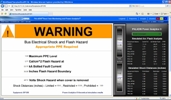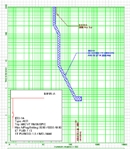
Detecting and Containing Arc Flash Incidents
Power analytics software calculates potential arc flash threats in real time, recommending appropriate safety procedures and PPE needed to work in the vicinity.
- By Jim Neumann
- Dec 01, 2010
In our fast-paced, competitive business environment, occupational health and safety professionals rely on technology to improve cost efficiencies, enhance service reliability, revitalize customer service, and affect the bottom line. Positively affecting the bottom line, however, means more than boosting profits. It also means containing the level and frequency of on-the-job accidents, as occupational health and safety experts often remind senior management. With increased government regulation and accelerated accident frequency, using powerful software technology to prevent accidents makes common sense (and cents).
According to the Institute of Electrical and Electronics Engineers (IEEE), electrical injuries in the workplace -- arc flash incidents, in particular -- result in the death of a facility worker every 48 hours. Such accidents occur even in facilities that have passed formal inspections within recent months. In fact, during a seven-year study conducted by the Bureau of Statistics, 2,576 U.S. workers died and another 32,807 sustained lost-time injuries (missing an average of 13 days away from work) due to electrical shock or burn injuries. These statistics were validated in a second study involving more than 120,000 employees that determined arc flash injuries accounted for 77 percent of all recorded electrical injuries.
Arc Flash Testing
The problem is that an arc flash incident can occur, without warning, anywhere high voltage is used. Incidents can occur even in facilities that have been rigorously inspected, such as data centers, manufacturing plants, commercial buildings, convention and hospitality centers, power generation and distribution infrastructure, retail space, or other facilities where high levels of electrical power are needed.
But just as law enforcement officials can only attempt to preempt crime -- by increasing surveillance, training on what to look for, investing in protective infrastructure, and so on -- facility operators historically have not been able to overcome the core problem: predicting when and where incidents will occur.
Although NFPA 70E Article 130.3 requires that an arc flash study be conducted at least every five years or whenever a major modification occurs, a study is painstaking, labor intensive, and may be outdated almost as soon as it is completed. This obsolescence could occur because of equipment changes, components handled during maintenance procedures, or just plain aging.
Such a study also may be expensive, increasing in cost by these factors: size of the facility for data collection, revision of one-line drawings, short circuit and protective device coordination studies, warning label installation, and arc flash training. For all of their good intentions, companies may be slower to spend money on inspections until the need for them is obvious.
In reality, however, even the best-designed, regularly inspected facility likely contains arc flash threats that emerge after inspectors leave. These risks may occur because of facility changes, equipment substitution, or maintenance procedures requiring workers to access off-limits areas for repairs.
The Rise and Fall of Arcing Current
Most of the arc flash studies done today use commercially available software that calculates arcing energy using the algorithm presented in IEEE-1584. The software performs a short circuit calculation to determine available bolted fault current. Once the arcing current is derived from the bolted fault current, the arcing current is then used to calculate fault-clearing time. Finally, the arcing energy is calculated using IEEE-1584 formulae.
Arcing energy essentially depends on arcing current and fault clearing time. An increase in arcing current will cause higher energy, providing that fault clearing time is constant. An example of that is shown Figure 1. However, arcing current often falls in the I2t region of solid state protective devices. Such a case is shown in Figure 2. Here, if arcing current is reduced, fault clearing time will increase, which will cause an increase in arcing energy.
 Figure 1. Case where increase in arcing current will cause higher arcing energy.
Figure 1. Case where increase in arcing current will cause higher arcing energy.
Figure 2. Case where decrease in arcing current will cause higher arcing energy.
Decreasing the fault level can increase arcing energy and increasing the fault level can increase energy of the arc. Although there are methods to find the maximum and minimum fault level in the network, unfortunately, those methods are not bound to reveal the worst-case arc flash.
The above examples illustrate the necessity to evaluate several network configurations. Different configurations (scenarios) will produce different short circuit levels, which translate to different arcing currents, fault clearing times, and finally, different arcing energies and arc flash boundaries. Evaluating multiple scenarios doesn't have to be arduous. As an alternative approach, a real-time software assessment, in specific environments, can significantly simplify the search for the worst-case scenario.
A Next-Generation Assessment
Fortunately, there are software products that can perform intelligent calculations about potential arc flash threats in real time. These software systems can significantly enhance worker safety in between required OSHA inspections. Within the past 18 months, a new software technology called "power analytics" has emerged. Though created primarily to ensure power reliability and energy efficiency, it has been proven to provide real-time arc flash assessments.
By definition, the term power analytics refers to integrated software technology that ensures an organization's electrical power infrastructure is optimally designed at the Computer Aided Design (CAD) stage and performs exactly as intended for reliability and energy efficiency. In addition, the software determines that the electrical system operates perfectly as organizations make real-time transitions between public and on-premises power sources in the grid management stages.
Once in the deployment/diagnostics stage, the diagnostics software maintains an uninterrupted watch over site operations, continually checking all components, equipment, and systems and comparing their "real world" status back to the original CAD model. When deviations are detected, the system performs the calculations necessary to make intelligent recommendations about where arc flash hazards have the potential to emerge and gauges their severity. By enabling real-time model-based diagnostics of power systems infrastructure -- incorporating the arc flash, power flow, short circuit, protective device coordination, etc. calculations from the original design model -- power analytics enables a facility operator to glean unprecedented visibility into operational detail and previously unpredictable events.
Having real-time arc flash, the facility manager does not need to worry about the off-line arc flash study he received. Did the consultant find the worst-case results? Did he assume some impossible scenarios and hence reach overly conservative results? All of these questions become obsolete. The system will go through all relevant configurations; therefore, all relevant scenarios will be explored.
Moreover, real-time arc flash analysis presents the users with the current arc flash results. A user knows the exact arcing energy for the given system configuration and can use that knowledge to perform work under energized conditions while the arc flash hazard is less severe.
Prior to entering an energized area and beginning daily tasks, a worker simply queries the system for a real-time arc flash status. It then responds with an up-to-date recommendation on the appropriate safety procedures and PPE necessary to work in the vicinity. Recommendations are based upon IEEE 1584 and the NFPA 70E standards.
Cristino Associates Inc. (http://www.cristino.com) is a Connecticut-based power engineering firm that provides structural, mechanical, and electrical design services. The firm's president, Joseph Cristino, P.E., said his staff regularly performs arc flash hazard analyses and uses the system in design work and protective device setting production work.
While no systems are 100 percent foolproof in detecting arc flash hazards, the new generation of power analytics technology seems to be the most promising development yet because it ensures workers are forewarned to the greatest extent possible about how to protect themselves.
About the Author
Vice President of Marketing Jim Neumann oversees EDSA Micro Corporation's marketing programs activities, bringing a wide range of large- and small-company software experience to the company. Prior to joining EDSA, he was vice president of IBM's Technology Group and director of IBM's Networking division, overseeing marketing and communications programs. He can be reached at [email protected] or 858-675-9211. Headquartered in San Diego, Calif., EDSA is a privately held developer of software solutions for the design, simulation, deployment, and preventative maintenance of complex electrical power systems.